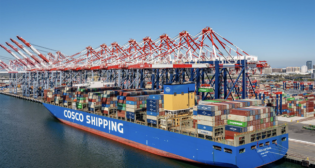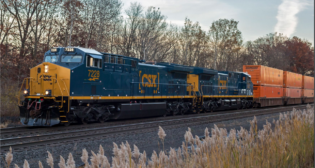
Some Questionable NS vs. CSX Analysis
Written by Rick Paterson, Managing Director, Loop Capital Markets
Some of these calculations may have well come from observing a black hole in deep space ... Shutterstock image.
On April 18, Ancora hosted a townhall in New York City for Norfolk Southern stockholders, and during that meeting [potential new NS board member] Gil Lamphere implored the audience to read the 193-page “Move NS Forward” slide deck. OK, but remember, you asked for it!
Given that we write a weekly report on railroad operating metrics, we’ll focus on, and fact check, some of the operating metrics Ancora is presenting to investors, specifically when they compare Norfolk Southern to its regional competitor, CSX.
You may have noticed that in our own reports we never compare railroads on any of the operating metrics, and in every report include this warning not to do so:
“While most of the railroad operating data is standardized in terms of how it is defined and measured, in some cases it is not and some railroads measure and capture the data very differently. Given these inconsistencies, readers should primarily focus on how these metrics change over time at each individual railroad and be very careful comparing railroads with each other on any of the reported numbers. Differences in business mix, length of haul, and geography further make direct comparisons inaccurate.”
We understand that in a proxy contest there need to be comparisons drawn, so Ancora has no choice but to try, so let’s treat this as a rare exception to the don’t do it rule. However, if you’re going to do it, you need to be transparent and proactive regarding context and caveats. This is where some of the Ancora analysis is, let’s just say, problematic.
Terminal Dwell
The most obvious and egregious error is on Slide 40, where on the last line they state Norfolk Southern’s 2023 terminal dwell of 25.7 hours was more than double CSX’s of just 9.4 hours, giving investors the illusion of a massive productivity improvement opportunity.

So where do these numbers come from?
In the chart below, we show recent terminal dwell for both. The black line is the weekly terminal dwell that NS reports to the STB. For 2023 it averaged 25.73 hours, matching Ancora’s number. It’s obviously CSX’s number where things go off the rails. The blue line shows CSX’s dwell that it also reports to the STB under the same STB-mandated definition. It averaged 19.7 hours in 2023, which is 23% lower (better) than NS. However, the big obvious here is that NS’s dwell was of course blown up by the East Palestine derailment and five-month remediation, which caused a bottleneck on its core route between Chicago and New York between Feb. 2 and July 5. If we exclude that period, NS dwell falls from 25.7 to 24.1 hours, which would place CSX 18% better. This might have been a legitimate comparison. But Ancora didn’t do that. Instead, it used the red line …

The red line in the chart shows terminal dwell taken from CSX’s website, which uses a very different definition. The STB definition of dwell specifically excludes run-through trains, which are trains that stop relatively briefly at yards to change crews without performing any switching work. Including run-through trains dramatically distorts terminal dwell (it’s basically a Canadian-originated trick to give the illusion of yard efficiency post-PSR). CSX, and some other railroads, report dwell inclusive of run-through trains on their Investor Relations website pages. For CSX, this takes its dwell number from, currently, 21.5 hours (except-run-through) to 10.3 hours (with run-through).
This is where Ancora’s 9.4 hours in 2023 comes from, which is obviously misleading in the extreme when compared against NS’s STB-defined dwell.
We haven’t spoken to Ancora and we’re not going to speculate how this error found its way into their presentation and why it has remained uncorrected. Yes, it’s just one number in a 193-page document, but it’s a critical one because dwell is foundational, and yards and terminals are where most of the costs reside.
Let’s keep going and continue with the analysis Ancora should have done. 2023 is history, so where are we in 2024? In the week ending April 19 (most recent data), CSX’s STB dwell was 21.5 hours vs. 22.7 hours at NS. That’s a 5.6% difference (72 minutes of dwell) in CSX’s favor, and light years from the 173% differential in the slide deck.
The argument Ancora is basically making to investors is that [proposed Chief Operating Officer Jamie] Boychuk is going to restructure and run the NS network better than the current NS management team. We can’t legitimately compare the two Eastern railroads for full-year 2023 because the comparisons are moot between Feb. 2 and July 5 (East Palestine) and after Aug. 4, when Boychuk departed CSX.
We can, however, get a rough sense of relative talent if we look at the most recent month of dwell at NS (four weeks through 4/19/24) and compare that to the exact same weeks at CSX in 2023, when Boychuk was COO. That results in average dwell of 22.8 hours at NS versus 18.8 hours at CSX under Boychuk, which is an 18% advantage to CSX/Boychuk. Of course, this analysis is also flawed because NS has a new COO, so we’re comparing Boychuk at his best to John Orr, who hasn’t yet hit his stride, plus the giant caveat that CSX and NS yards obviously differ in number, size, configuration, density, and the IT systems that manage them.
Now you see why we include a wall of text in every report warning people not to try this at home. All the analysis in the world will only take you so far, and what you’re left with is a gut feel for the difference. For what it’s worth, our best guess regarding the percentage differential in yard efficiency between CSX and NS, as they’re currently operating, is probably in the high single-digits, and the case can be made for the teens with Boychuk given CSX’s dwell has deteriorated since his departure.
Let’s move on, but it goes without saying that this dwell debacle was a bit of a credibility killer in our eyes, and we shouldn’t have had to waste time fact checking something as basic as terminal dwell.
Trains Holding for Power
This one’s on Slide 51 and again gives the impression NS is a basket case compared to perfection at CSX. As a reminder, trains holding for power is a once per day count of the number of trains that have not departed on time due to a failure of locomotive availability, at that time (so it understates total trains held). NS performs this count at 6:00 AM every day and marks a train held if departure is more than four hours late, while CSX performs its count at 3:30 AM with late cutoffs of one hour for scheduled traffic (manifest and intermodal) and eight hours for bulk. This information is based on conversations with Investor Relations at both in recent years.

The historical rule of thumb for trains holding for power (and separately, crews) for the two Eastern railroads is that anything 10 or over per day is bad (short power), anything under five per day is good (long power), and 5-9 is in the grey area. Ancora’s chart shows NS at two per day in 2019, 0.5 in 2020, five in 2021, 16 in 2022, and 12 in 2023. CSX’s numbers are 0.9 per day in 2019, 2.1 in 2020, and virtually nothing since.
Here’s a chart we’ve pulled together that shows the same data on a weekly basis:

If we start with Norfolk Southern, trains holding for power was generally below five per day and in decent shape in 2019, 2020 and most of 2021. NS then melted down in late October 2021, which blew up every metric, including this one, and the recovery and normalization between September 2022 and February 2023 was of course short-lived due to East Palestine. In more recent times, trains holding for power is in good shape, averaging just 3.6 over the past five weeks through 4/19/24.
Regarding CSX, we’re going to try to resist a full-page rant here, because this is one of our bugbears with the company. Most of CSX’s weekly operating data points are credible and reliable. This isn’t one of them.
In the chart you can see a smattering of trains held for power from October 2019 to July 2020, which has since petered out to almost nothing. For example, year-to-date, CSX has reported zero trains holding for power in every week except one. After July 2020, CSX has either stealth re-defined it down to near-zero or philosophically doesn’t think it needs to report it, despite the STB requirement. The fact that CSX reported exactly zero trains holding for power in every week during its own meltdown in 2022 tells you everything you need to know about how seriously the railroad takes this metric in terms of public disclosure. We’ve become so exasperated with it we’ve recently taken to making Star Trek jokes in our reports that CSX has starting beaming locomotives around because there’s no other possible explanation for its apparent perfection in locomotive availability (do you need to stand them on their end to fit in the transporter?).
The bottom line here is that Ancora is comparing a Norfolk Southern metric that has trended rationally and reasonably relative to events on the ground to a CSX number that it doesn’t effectively report.
And for the record, Ancora is not to blame here. This one’s on CSX.
Wrap-Up
There are other NS vs. CSX comparisons in Ancora’s slide deck we could pick apart, such as recrews and the dubious claim that NS switches manifest cars twice as much as CSX, but you get the picture. Yes, CSX runs a more efficient operation than NS, but the magnitude of the gap cannot be accurately quantified on any metric, and the implied differences in productivity are exaggerated in Ancora’s analysis and should be viewed with a very skeptical eye.



